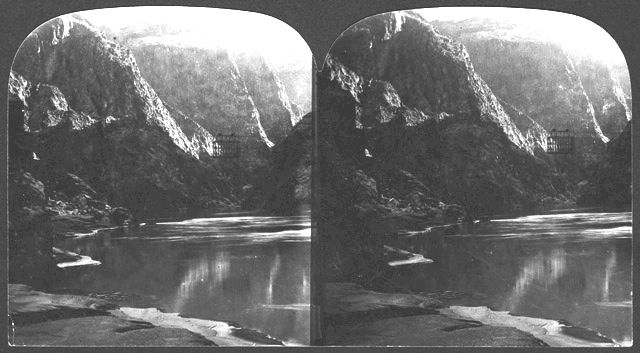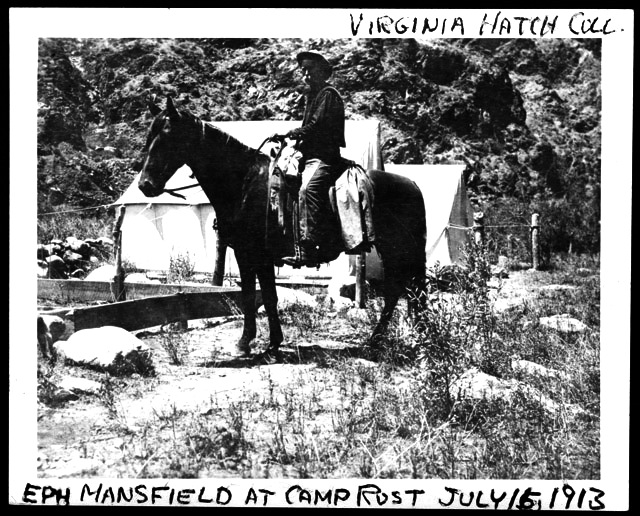he North Rim saw its share of Euro-American miners, ranchers, explorers, and entrepreneurs, though not nearly in the same numbers as on the South Rim. Still, the actions of early Euro-Americans, such as Edwin Dilworth “Uncle Dee” Woolley and David Rust, influenced the development of the North Rim of Grand Canyon National Park and have continued to shape the way modern visitors experience that side of the Canyon.
“Uncle Dee” was an entrepreneur in the Arizona Strip who worked hard to bring tourism to the lands to the north of the Grand Canyon. He and other investors formed the Grand Canyon Transportation Company in 1903. They tried vigorously to convince nearby railroads to build spurs to the Grand Canyon, but none were interested in spending the money on a dead-end line to a remote, unpopulated, and economically dull area.
Rather than give up, Woolley continued to think of ways to bring tourists to the North Rim. He hired his son-in-law David Rust to build a trail down to the Colorado River that could accommodate tourists. The site they chose was near Blondie Jensen Spring at the head of an ancient Native American trail that followed Bright Angel Creek down into the Canyon.
Four years later, in 1907, Rust completed the trail, as well as the building today known as the Uncle Dee Woolley Cabin at its head. Parts of this trail would later be incorporated into the North Kaibab Trail . Rust also built a tent camp near the site of today’s Phantom Ranch and engineered a cable tram system to move people, supplies, and animals across the Colorado River.
Once the trail was complete, the Grand Canyon Transportation Company began offering tours from Kanab, Utah, to Bright Angel Point, and from Bright Angel Point down into the canyon. Their business was limited to the summer months because cold and snowy winters were the norm due to the high elevation of the North Rim. Rust would spend his winters teaching and sometimes working as a newspaperman, and in the summer would guide tourists and manage the Company. The Company would transport tourists to their cabin at the trailhead in wagons over bumpy cattle paths. From the cabin, Rust would lead them down the trail, and they would spend the night at Rust’s Camp on the north side of the Colorado River at the bottom of the canyon.

In 1906-1907 David Rust constructed this tramway across the Colorado River for the Grand Canyon Transportation Company. It connected the trail he built into the Canyon from the Woolley Cabin on the rim to his camp near modern-day Phantom Ranch.
Photo: NAU.PH.568.9399. Kolb Bros. Collection. Cline Library, Northern Arizona University.

David Rust built this camp near today’s Phantom Ranch as a spot for his visitors to spend the night before ascending the trail back to the Woolley Cabin on the North Rim. Here Eph Mansfield is shown on a horse at the camp in 1913, the same year that President Theodore Roosevelt camped there overnight. Because Rust only guided tours in the summer, many people who descended into the Canyon from the South Rim in the wintertime assumed it was abandoned, and because Roosevelt had stayed there it was often mistakenly referred to as Camp Roosevelt.
Photo: NAU.PH.97.46.111.59. P.T. Reilly Collection. Cline Library, Northern Arizona University
In 1909, to drum up business, Woolley arranged for two automobiles to make a round trip from Salt Lake City to the north rim of the Grand Canyon and back. At the time, there were no gas stations in the area vicinity of the North Rim and roads were little more than rutted dirt paths. Gas was shipped to the area by train and hauled by wagon to the car route, which later became Highway 89. This stunt still failed to make the North Rim a major tourist destination, however.
Though they never sold their interests, neither Woolley nor Rust lived at the Canyon year-round. Their attentions, and were often distracted by other interests. For example, in another business venture that also never quite took off, Woolley raised “cattalo,” a hybrid between a buffalo and cattle, on the Arizona Strip. In 1915 Rust finally decided to stop his summer tour guiding at the Canyon.
Replacing him, so instead Aldus “Blondie” Jensen and his wife Melissa took up residence in the Woolley Cabin and offered saddle trips up and down the path Rust had developed into the canyon along Bright Angel Creek. They soon found themselves competing with Thomas and Elizabeth Wylie McKee’s concession at Bright Angel Point, closer to the Rust trail head. Still, the Woolley Cabin remained a landmark for visitors traveling to the North Rim along the bumpy, rutted paths that brought them south from their Utah jumping-off points to the Grand Canyon in the 1910s and 1920s.
Written By Sarah Bohl Gerke
References:
- Anderson, Michael. Polishing the Jewel: An Administrative History of Grand Canyon National ParkGrand Canyon Association, 2000.
- Rust, Joseph. “From the Dirty Devil to the Bright Angel: The History of David D. and Ruth W. Rust.” 1995.
- Available online: http://www.gchba.org/Story%20of%20Dave%20Rust%20by%20Jos%20Rust.pdf

